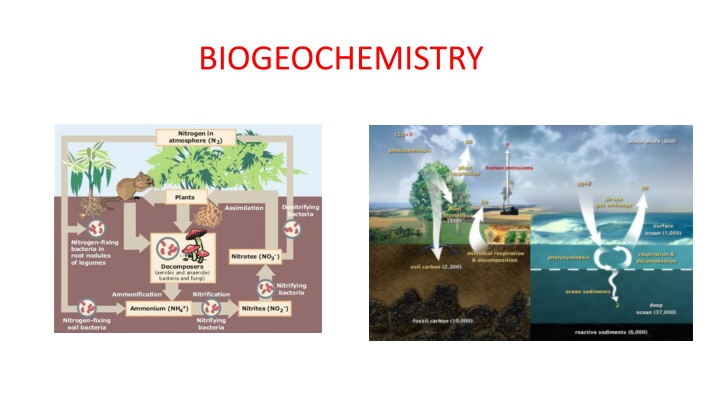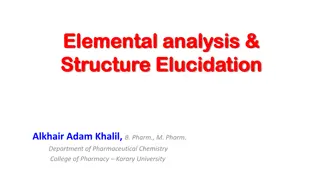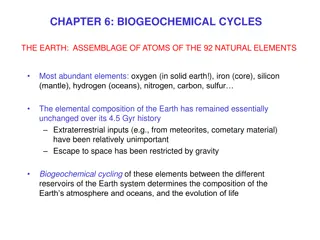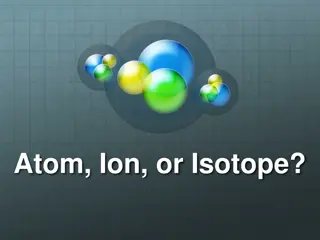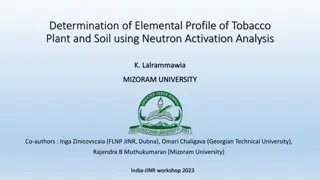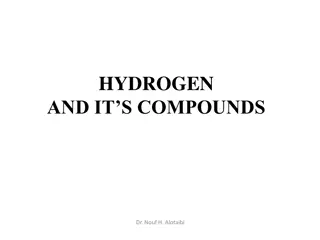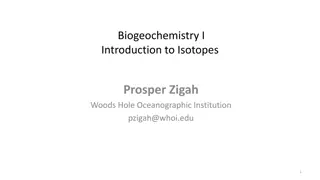Biogeochemistry: Study of Elemental Cycles and Isotopes
Biogeochemistry delves into the intricate relationships between biological, geological, and chemical factors, exploring the movement of chemical elements through various ecosystems. This study encompasses microbial processes, ecosystem dynamics, and global interactions, highlighting the interconnectivity of elemental cycles such as carbon, nitrogen, phosphorous, and sulfur. Isotopic analysis plays a pivotal role, unraveling unique signatures in different reservoirs and organisms, offering insights into dietary habits and ecological functions.
Download Presentation

Please find below an Image/Link to download the presentation.
The content on the website is provided AS IS for your information and personal use only. It may not be sold, licensed, or shared on other websites without obtaining consent from the author.If you encounter any issues during the download, it is possible that the publisher has removed the file from their server.
You are allowed to download the files provided on this website for personal or commercial use, subject to the condition that they are used lawfully. All files are the property of their respective owners.
The content on the website is provided AS IS for your information and personal use only. It may not be sold, licensed, or shared on other websites without obtaining consent from the author.
E N D
Presentation Transcript
What is Biogeochemistry? The study of the biological, geological and chemical factors that influence the movement of chemical elements through living systems across space and time. Processes can be studies at the microbial, ecosystem and global scales Scales are becoming increasingly integrated. Ex: The role of microorganisms in carbon cycling and global climate change Elements cycle through reservoirs often termed as source or sink Matter of perspective and what is being measured Ex. Plant biomass is a sink of atmospheric carbon (CO2) via photosynthesis Burning of fossil fuels (i.e. dead plants) is a source of carbon to the atmosphere
Four main elemental cycles Carbon (C) Nitrogen (N) Phosphorous (P) Sulfur (S) Elements do not cycle independently. Ex: Denitrification (N03 N2) requires C that is easily consumed by microbes
Carbon Cycle Notice: natural processes of photosynthesis and respiration are nearly equal if not slightly in favor of storage in biota, soils, and ocean surface water UNITS! Gigatons C/Year Short Term Storage Significant Microbial Component Long Term Storage
Nitrogen Cycle Highly abundant form of N. Inaccessible to most organisms due to the triple bond between N atoms. Primarily rely on nitrogen fixing bacteria to introduce bioavailable N to ecosystems. (Note: Some trees can fix N due to symbiotic relationship with bacteria.) Critical microbial components at all stages. DON Main mechanism in which nitrogen is removed from ecosystems
Concern of acid rain via Industrial Processes Sulfur Cycle Important microbial component
Phosphorous Cycle Weathering of rock is the original source of P No gaseous phase Important microbial component
Isotopes: a powerful technique in Biogeochemistry Isotopes: atoms of the same element that vary in atomic mass due to different number of neutrons Two most common in Biogeochemistry research Carbon: 12C, 13C Nitrogen: 14N, 15N Different reservoirs have isotopic signatures Plants: higher 13C:12C than the atmosphere Nitrogen in the ocean: higher 15N:14N signature than terrestrial bound nitrogen Organisms higher on the food chain have higher 15N values }Research implications? Vegetarian/vegans have lower 15N values
Two main isotopic techniques Relative Abundance: measure isotopic ratios to determine if something is changing Ex: The ratio of atmospheric 13C:12C is increasing indicating more plant-based carbon is entering the atmosphere What is the source of this new plant-based carbon? Stable Isotopes: Raise the amount of the rarer isotope way above background levels and follow it through a system Ex: 15N can be added to a stream and measured downstream to determine the demand for N by microorganisms.
